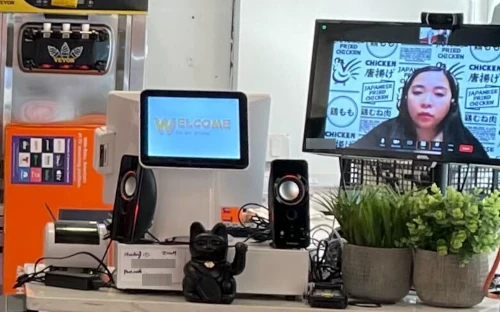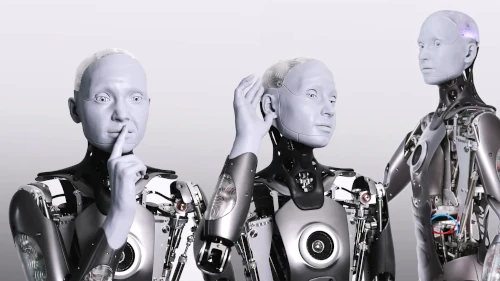New York: Cashiers Replaced by Filipinos Working from Their Country for $3.75 an Hour

Picture this: You’re at a restaurant in Manhattan, let’s say Sansan Chicken. You order your fried chicken by talking to a tablet sitting on the counter. On the screen, a smiling face responds to you in real time. The employee takes your order and processes your credit card payment… except she’s not in New York. She’s in the Philippines. 8,000 miles away! And she only makes $3.75 an hour. Yes, you read that right: $3.75 an hour!
While you’re enjoying your chicken lunch in Manhattan, the person who just took your order is working the night shift from Manila because of the 12-hour time difference. And here’s the most outrageous part: the system still asks you to leave a tip that can go up to 18% on your final bill.
So maybe you’re thinking this is some dystopian fiction? Unfortunately, it’s already a sad reality because companies like Happy Cashier and CloudStaffs are placing Filipino cashiers in several New York restaurants via a simple tablet and a Zoom connection.
Why has it come to this outrage? Because in New York a cashier costs about $20 an hour plus payroll taxes. Because rents are exploding and many small restaurants are on the verge of bankruptcy. So some have found a workaround that involves hiring people halfway around the world to slash cashier labor costs by five and stay open. And on the Philippines side, it’s seen as an opportunity because $3.75 an hour is still higher than the average local wage.

We already talked about a similar case on NovaFuture with robots in Japan that are remotely piloted by underpaid Filipino workers for $2 to $3 an hour. At that point, we honestly thought we’d hit rock bottom and that it was an isolated case. But actually, we just discovered this other equally disgusting version where even the physical robot has disappeared. So we’re getting the feeling that this aberration is rapidly gaining ground.
But the worst part is that this story is just getting started! And what’s being presented as an “innovative solution” to save restaurants might just be the second-to-last step before something far more radical. So take the time to read this article carefully because there’s a good chance you don’t yet realize what’s coming in the very near future.
What this virtual offshoring reveals about modern capitalism
It’s disgusting, it’s inhumane… We can say that without hesitation. But that’s not all because this situation reveals something deeper once again: Unbridled capitalism is self-devouring. In other words, it eats itself alive.
Here’s the thing: If local jobs disappear because they’re all offshored to the other side of the world… who will still have money to come eat at restaurants? Because in New York a cashier making $20 an hour is also a consumer. Someone who spends locally, who keeps the neighborhood economy going, and who pays their rent. By replacing them with an invisible worker in the Philippines, we destroy this entire local economic cycle. And the laid-off cashier is left with nothing but their tears and food stamps to feed their family.
So it’s the story of the snake eating its own tail. Restaurants think they’re boosting their margins in the short term, but at the same time they’re helping to drain local purchasing power. And therefore reducing their own customer base. Meanwhile, in the Philippines, workers are being exploited working night shifts with a 12-hour time difference for wages that are pitiful by Western standards. So everyone loses. Except the shareholders who scrape together a few margin points. Which is typical of unbridled capitalism that generates a perpetual race to the bottom where everyone ends up in poverty… Except a small handful of so-called winners who optimize their profits by creating human dramas without any conscience whatsoever.
What technologies are still missing before we find robot cashiers everywhere?
Let’s get back to our Filipino cashier on Zoom. An analyst asked the uncomfortable question: “If someone can already process payments from the other side of the world… how long before an AI-powered robot does the job instead?”. And that’s when everything shifts! Because technically speaking, we’re very close.
But forget the idea of an ultra-sophisticated humanoid robot that walks, runs, jumps, does kung fu… We don’t need that for a cashier. So the requirements are much simpler: A seated robot (no need to manage bipedal walking, the most complex and expensive thing), fluid movements of the torso and arms to move naturally, an ultra-realistic expressive face capable of communicating emotion, and a powerful conversational AI that can chat, reassure, and joke around.
So where are we technically? Fluid movements are already there. Look at the demos of Figure 02, Mercedes’ Apollo, or Chinese robots like Unitree G1: They move naturally and convincingly. Conversational AI? Fully operational. GPT-5, Claude and the others can already hold a fluid, natural, empathetic conversation with emotional nuances. As for realistic expressive faces, we’re very close: Ameca (Engineered Arts) already does mind-blowing micro-expressions, photo-realistic silicone masks exist, and we’re progressing at breakneck speed on this front.

And the cost? In free fall! Experimental Chinese robots produced by hand cost around $10,000. In mass production within 3 to 5 years, we can expect about $20,000 for top-of-the-line professional versions. And what’s $20,000 compared to a New York cashier who costs $40,000 a year plus payroll taxes? A return on investment in six months! So everyone’s going to jump on it to increase margins because the numbers speak for themselves.
But it doesn’t stop there! Because a high-performing robot cashier won’t just be a machine that processes payments. It’ll be a super-cashier with capabilities no human can match. Instant facial recognition to greet you by first name as soon as you enter a store. For example: “Hi Emmanuel! Great to see you again. Ginger spicy chicken as usual?” All this with an elephant’s memory that remembers all your preferences, your allergies… In short, all your habits. Plus very subtle emotional manipulation consisting of a perfect voice tone, a warm smile, and empathy calculated to the millimeter. The robot will never be tired, never in a bad mood, never unpleasant, and never rushed.
And you know what’s going to happen? People will end up preferring the robot. Because it’ll be more patient, more cheerful, and more attentive than a human. Because it’ll never judge you. Because it’ll always be friendly, even at 3 AM on a Saturday night when you’re a bit drunk and ordering randomly. As a result, this will create attachment to machines and people will defend the robots. Like: “Oh no, I prefer the robot because it’s so nice to me!”
What about security then? You might be thinking: “Yeah, but if it’s a robot at the register I can just leave without paying and that’s it.” Except the solution already exists and it’s very simple to implement. At the restaurant entrance, you scan your credit card or an RFID badge and you’re “registered” in the system. At the exit, if payment went through, the door opens automatically. And if there’s a problem, the door stays locked and an alert goes off. The robot then contacts a remote human (irony of all ironies: maybe a Filipino) or directly the police.
So in the end, no science fiction because this technology already exists. Amazon Go has been testing it for years. It’s mature, it’s reliable, and it’s deployable everywhere at low cost. Result: the robot isn’t just a cashier, it’s also the security guard. Two jobs in one. And all this without human resource management and without unions to deal with. In short, we’re swimming in capitalist paradise. So it’s no wonder all the libertarian billionaires are already all-in on this technology. Even if it means sawing off the branch they’re sitting on. Which is a sign that they’re probably not the geniuses they claim to be.
From offshoring to total automation of customer service and checkout, the final stage is fast approaching
So when is this coming? In 2 to 3 years for the first real deployments. And in 5 to 7 years for massive adoption. Because everything is already there, or almost. All that’s missing is a bit more reliability (we’re at 85-90% depending on use cases and we need to reach 98-99% for professional use), mass serial production to bring costs down, and social acceptance that will come quickly because people will prefer a friendly robot to a cold tablet or a human cashier with uneven moods.
And meanwhile, what are Filipino cashiers working via Zoom actually doing? Well, they’re training the AI without knowing it. Every order taken, every problem solved, every customer interaction: everything is carefully recorded, analyzed, and digested by the AI. Because despite themselves, they’re providing valuable data that will allow the machine to replace them. It’s the classic modern industrial pattern, one we’ve seen thousands of times… I’ve had the opportunity to work in China and I know exactly what I’m talking about.
First, you hire humans telling them “You’re valuable, we need you.” Then you collect their data, analyze every gesture, every decision… meanwhile, the AI learns in silence. Sometimes, in the best case, you warn the human first to better fool them: “The AI is going to assist you, you’ll then work in cooperation with it. It’s to reduce the strain of your work.” Sometimes you say nothing at all. Then, as soon as the AI reaches 98% reliability, you fire the human. “Sorry, we don’t need you anymore. You’ve become obsolete.” The model then spreads to the entire industry concerned. So workers look elsewhere… but “elsewhere” has already automated too. Then it’s game over. The worker has lost everything and no alternative is offered to them.
Meanwhile, Filipino cashiers think they’ve found a stable job. When in reality they’re training their own replacements. And when the AI is ready, they’ll be fired overnight. Like the millions of other workers in call centers, customer support, translation, and all service jobs. But also white-collar workers: doctors, lawyers, accountants, pharmacists… And this time, unlike other technological revolutions of the last century, there will be nowhere to retrain because this pattern is repeating everywhere at once.
And during this time when everything is being set up under the radar, we’re being told the fable: “Yes, but it’s going to create millions of skilled, well-paid jobs!” When that’s false. Utterly false! Because the robots that will replace cashiers, will they be manufactured by other robots or by cashiers? And the AI that will replace developers? At what level will it still need humans? So we’re not replacing 10 million low-skilled jobs with 10 million engineering jobs. It’s an illusion, a lie we tell ourselves to avoid facing the reality that we’re becoming obsolete compared to the efficiency of machines. This isn’t new. It happened with steam engines, with assembly line work, with computers, and with the internet. However, the big news is the scale and speed at which it’s happening. Not to mention that for the first time in human history, intellectual work is also being automated.
So what do we become in all this? There’s really reason to worry because absolutely nothing is planned politically to effectively manage this major technological shift that’s proving inevitable. No party, no political side is really anticipating what’s coming. We vaguely talk about “transition,” about “training”… but nobody’s asking the real questions. Like: How do we redistribute productivity gains? How do we guarantee income to those who no longer have jobs? How do we avoid social explosion? In short, politicians are all clueless. And when we see that in some major countries leaders are over 75 years old and don’t understand anything about technology and its challenges… Yes, there’s double reason to worry.
So instead of looking for solutions right now so that this technology allows us to move toward a society where we have time to flourish and where everything is done in this direction, we’re going to see an explosion in demand for food stamps and populism that’s going to skyrocket, treating people who’ve lost their jobs as “losers” and “useless to society.” And in return, it’s more than obvious that a very violent anti-technology movement is going to manifest on a large scale. So yes, it’s inevitably going to be violent! Simply because capitalism is violent by nature and violence breeds violence. Still doubting it? Firing an employee just by sending them a text or email is super violent! Ravaging the environment just to rake in financial profits is violent! Treating living beings as mere products is violent! And I’m going to stop there because if I have to mention everything violent about capitalism, it’ll take you at least two days of reading to get to the end of this article.
Techno-catastrophe or techno-emancipation? It’s up to us to choose
Let’s be very clear: At NovaFuture we’re not against technology. A robot that processes payments instead of a human? Why not… Because nobody dreams of spending their life behind a cash register. So the problem isn’t the robot, or the AI. The big problem is how we manage it intelligently.
Two scenarios are possible. The first is the current scenario of unbridled capitalism: We fire local cashiers, we exploit Filipinos long enough to train the AI, we fire them as soon as the machine is ready, we don’t redistribute anything, and we witness an explosion of unemployment, a rise in populism, social anger, and violence. The second is the alternative scenario that we’re not given the opportunity to decide collectively: We automate tedious tasks, we share productivity gains (universal income, 3-day work week or less…), we support career transitions with dignity, and we free up time to create, learn, or simply enjoy life.
Technology can do anything. But it all depends on who controls it and for what purpose. Right now, it’s only in the hands of tech billionaires. That’s the real scandal! Not the robot, not the AI. So at NovaFuture we’re not advocating for a return to the Stone Age. Rather, we believe in a future where technology serves humanity and not the other way around. A future where automation is no longer a threat but a liberation. But to achieve this result, we need real political and economic evolution. An evolution where the well-being of humans and their environment are at the center of decision-making. And the stakes are high enough, for us, for our children, for our families… to make it really worth fully committing to obtaining a future where it’s good to live together. On our end, that’s what we’re doing with NovaFuture by proving through concrete examples that another world is possible. A world based on sharing and not on constant competition between individuals. What do you think? Want to discuss it in the comments?
If you found this article useful and want to see more on NovaFuture, please take a few seconds to support the site by buying us a coffee. Without reader participation, it’s very difficult for us to meet our operating budget. So it would be really nice if you made a small effort on your end. Also take a few extra seconds to share this piece with others. And see you very soon for new adventures 🙂